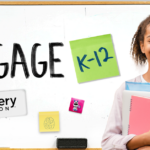By Ben Brazeau
In today’s diverse classrooms, the importance of inclusive education cannot be overstated. Every student brings a unique set of strengths, challenges, and learning styles to the classroom, making it essential for educators to create environments that support the success of all learners. As we navigate the complexities of modern education, the concept of inclusivity has evolved beyond mere accommodation to become a cornerstone of effective teaching practices.
Consider Sarah, a fifth-grade student who struggles with dyslexia. Despite her intelligence and creativity, traditional teaching methods often leave her feeling frustrated and left behind. It’s a scenario familiar to many educators—a reminder of the diverse needs present in every classroom.
As educators, we embark on a journey to meet these diverse needs, armed with theories and strategies acquired through our training and experience. However, theory alone isn’t always sufficient. Educators are practitioners, and as such, are called to put theory into practice.
In today’s digital age, technology can play a crucial role in promoting inclusivity in education. By leveraging digital accessibility tools, educators can customize learning experiences to meet the diverse needs of students. For example, immersive reading software and screen readers enable alternative methods of accessing text for struggling readers. Multimedia presentations and closed captioning support diverse learning styles, enhancing comprehension and retention. Digital resources and universal design principles, can ensure that all students, regardless of their backgrounds, abilities, or learning styles, have equitable access to education and opportunities for success. Below is a selection of powerful edtech tools that educators can use to make turn the theory of inclusivity into practice:
Screen Readers
Screen readers are assistive technologies that convert digital text into speech or braille, allowing individuals with visual impairments or reading difficulties to access written content. By audibly presenting text, screen readers facilitate comprehension and engagement for diverse learners. For example, a high school teacher incorporated screen readers into their classroom by providing students with visual impairments access to digital textbooks and online resources, enabling them to participate fully in class discussions and complete assignments independently.
Digital devices like iPads and Chromebooks often come equipped with built-in accessibility tools. On the iPad and iPhone there is a feature called Spoken Content. Students can turn this on and when they highlight text it will read the text to them. This can be a single word to help them with pronunciation or entire pages. Text Help offers a Chrome extension that students can use to have text read to them. Companies like Discovery Education have partnered with companies like Microsoft to include Immersive Reader into their platform to support students.
Audio Books
Audio books provide an alternative format for accessing written content, benefiting students with dyslexia, auditory learners, or those who struggle with traditional reading methods. By listening to narrated text, students can improve comprehension and retention. Many school librarians subscribe to services such as Follett or Discovery Education Experience, thereby integrating audio books into their school library’s collection. This offers students with reading difficulties access to popular titles in audio format, fostering a love for reading and supporting literacy development.
Closed Captioning
Closed captioning displays text on screen that corresponds to spoken dialogue or audio content, benefiting students with hearing impairments, language learners, and those who prefer visual reinforcement. Many platforms like YouTube, Discovery Education Experience and others incorporate closed captions into their videos that provide visual cues alongside audio content. Closed captioning enhances comprehension, language acquisition, and accessibility. One middle school science teacher I know incorporated closed captioning into educational videos used for remote learning, ensuring that all students, including those with hearing impairments, could access and understand the content.
Scaffolds to Writing
Scaffolds to writing encompass tools and strategies that support students in expressing their thoughts and ideas through written communication. Dictation software, such as Google’s speech-to-text or Apple’s Dictation tools, allows students to dictate their thoughts verbally, which are then transcribed into written text. An English language arts teacher implemented dictation software in the classroom to support students with dysgraphia, enabling them to overcome barriers to written expression and participate more fully in writing assignments. An elementary teacher implemented audio recording software to unlock student’s ability to express themselves. Ask a first grade student to share with you what happened on their summer break and you might get a few sentences to a couple paragraphs. Allow them to record or dictate their response and you will understand the potential these tools have for empowering students.
Dictation
Writing is a crucial skill, but for students with fine motor skill difficulties or other challenges, traditional writing methods may pose barriers. Dictation software, like Google’s speech-to-text or Apple’s Dictation tools, can improve writing fluency, and confidence. They can then read, revise and refine their ideas into a written expression of their knowledge.
Audio/Video recordings
Audio/video recordings not only enhance engagement and self-reflection but also allow students to showcase their personality and creativity. Engage students through the use of audio/video projects to not only demonstrate their understanding but it can also help us see their personality shine through. Students can do their greatest sports announcer, or news anchor impression as they highlight their mastery of concepts.
AI Tools
Empowering students to advocate for themselves and removing obstacles to learning are paramount. The accessibility features previously shared highlight tools that students can utilize to help them engage with text or content materials. Artificial intelligence (AI) has revolutionized the way we support inclusive practices in education. Tools like Diffit.me, Brisk.ai, and Magicschool.ai leverage AI to support inclusive practices, enabling teachers to create customized lesson plans, text materials, and activities that meet the needs of all students. These tools are game changers for addressing the needs of our students. Teachers have tools that can within a few minutes create lessons that support all students, level texts, design inclusive activities and break down barriers.
In conclusion, creating inclusive learning environments necessitates a comprehensive approach, integrating digital tools and strategies to effectively support the diverse needs of learners. By embracing these tools and practices, educators can cultivate an environment where all students have equitable access to information and opportunities for success. It is crucial to provide all students with access to these tools, recognizing that what benefits some may potentially benefit all. By offering students the autonomy to choose the resources that best suit their learning preferences and needs, educators mitigate the risk of singling out students with difficulties and instead foster a culture of inclusivity. In essence, the implementation of various tools and strategies is paramount to creating a learning environment where every student feels valued, supported, and empowered to thrive.

Ben Brazeau is an Instructional Technology Coordinator at Shawano School District in Shawano, Wisconsin
The American Consortium for Equity in Education, publisher of the "Equity & Access" journal, celebrates and connects the educators, associations, community partners and industry leaders who are working to solve problems and create a more equitable environment for historically underserved pre K-12 students throughout the United States.
- American Consortium for Equity in Educationhttps://ace-ed.org/author/admin/
- American Consortium for Equity in Educationhttps://ace-ed.org/author/admin/April 23, 2025
- American Consortium for Equity in Educationhttps://ace-ed.org/author/admin/
- American Consortium for Equity in Educationhttps://ace-ed.org/author/admin/







